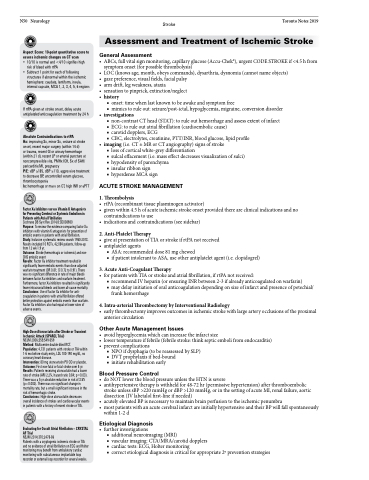Page 792 - TNFlipTest
P. 792
N50 Neurology
Aspect Score: 10-point quantitative score to assess ischemic changes on CT scan
• 10/10 is normal and <4/10 signifies high
risk of bleed with rtPA
• Subtract 1 point for each of following
structures if abnormal within the ischemic hemisphere: caudate, lentiform, insula, internal capsule, MCA 1, 2, 3, 4, 5, 6 regions
If rtPA given at stroke onset, delay acute antiplatelet/anticoagulation treatment by 24 h
Absolute Contraindications to rtPA
Hx: improving Sx, minor Sx, seizure at stroke onset, recent major surgery (within 14 d)
or trauma, recent GI or urinary hemorrhage (within 21 d), recent LP or arterial puncture at noncompressible site, PMHx ICH, Sx of SAH/ pericarditis/MI, pregnancy
P/E: sBP ≥185, dBP ≥110, aggressive treatment to decrease BP, uncontrolled serum glucose, thrombocytopenia
Ix: hemorrhage or mass on CT, high INR or aPTT
Factor Xa Inhibitors versus Vitamin K Antagonists for Preventing Cerebral or Systemic Embolism in Patients with Atrial Fibrillation
Cochrane DB Syst Rev 2014;8:CD008980
Purpose: To review the evidence comparing factor Xa inhibitors with vitamin K antagonists for prevention of embolic events in patients with atrial fibrillation. Study: Inclusive systematic review search 1950-2013. Results included 10 RCTs, 42,084 patients, follow-up from 12 wk-1.9 yr.
Outcome: Stroke (hemorrhagic or ischemic) and non- CNS embolic event
Results: Factor Xa inhibitor treatment resulted in significantly fewer embolic events than dose adjusted warfarin treatment (OR 0.81; CI 0.72 to 0.91). There was no significant difference in rate of major bleeds between factor Xa inhibitors and warfarin treatment. Furthermore, factor Xa inhibitors resulted in significantly fewer intracranial bleeds and lower all-cause mortality. Conclusions: Use of factor Xa inhibitor for anti- coagulation in patients with atrial fibrillation offered better protection against embolic events than warfarin. Factor Xa inhibitors also had equal or lower rates of adverse events.
High-Dose Atorvastatin after Stroke or Transient Ischemic Attack (SPARCL Trial)
NEJM 2006;355:549-559
Method: Multicentre double-blind RCT.
Population: 4,731 patients with stroke or TIA within 1-6 mo before study entry, LDL 100-190 mg/dL, no coronary heart disease.
Intervention: 80 mg atorvastatin PO OD or placebo. Outcome: First non-fatal or fatal stroke over 5 yr. Results: Patients receiving atorvastatin had a lower rate of stroke (ARI 2.2%, hazard ratio 0.84; p=0.03). There was a 5 yr absolute reduction in risk of 3.5% (p=0.002). There was no significant change in mortality rate, but a small significant increase in the risk of hemorrhagic stroke.
Conclusions: High-dose atorvastatin decreases overall incidence of strokes and cardiovascular events in patients with a history of recent stroke or TIA.
Evaluating for Occult Atrial Fibrillation – CRYSTAL AF Trial
NEJM 2014:370;2478-86
Patients with a cryptogenic ischemic stroke or TIA and no evidence of atrial fibrillation on ECG and Holter monitoring may benefit from ambulatory cardiac monitoring with subcutaneous implantable loop recorder or external loop recorder for several weeks.
Stroke Toronto Notes 2019 Assessment and Treatment of Ischemic Stroke
General Assessment
• ABCs,fullvitalsignmonitoring,capillaryglucose(Accu-Chek®),urgentCODESTROKEif<4.5hfrom
• • • • •
•
•
symptom onset (for possible thrombolysis) LOC(knowsage,month,obeyscommands),dysarthria,dysnomia(cannotnameobjects) gazepreference,visualfields,facialpalsy
armdrift,legweakness,ataxia
sensationtopinprick,extinction/neglect
history
■ onset: time when last known to be awake and symptom free
■ mimics to rule out: seizure/post-ictal, hypoglycemia, migraine, conversion disorder
investigations
■ non-contrast CT head (STAT): to rule out hemorrhage and assess extent of infarct ■ ECG: to rule out atrial fibrillation (cardioembolic cause)
■ carotid dopplers, ECG
■ CBC, electrolytes, creatinine, PTT/INR, blood glucose, lipid profile
imaging(i.e.CT±MRorCTangiography)signsofstroke
■ loss of cortical white-grey differentiation
■ sulcal effacement (i.e. mass effect decreases visualization of sulci) ■ hypodensity of parenchyma
■ insular ribbon sign
■ hyperdenseMCAsign
ACUTE STROKE MANAGEMENT
1. Thrombolysis
• rtPA(recombinanttissueplasminogenactivator)
• givenwithin4.5hofacuteischemicstrokeonsetprovidedthereareclinicalindicationsandno
contraindications to use
• indications and contraindications (see sidebar)
2. Anti-Platelet Therapy
• give at presentation of TIA or stroke if rtPA not received • antiplateletagents
■ ASA: recommended dose 81 mg chewed
■ if patient intolerant to ASA, use other antiplatelet agent (i.e. clopidogrel)
3. Acute Anti-Coagulant Therapy
• forpatientswithTIAorstrokeandatrialfibrillation,ifrtPAnotreceived:
■ recommend IV heparin (or ensuring INR between 2-3 if already anticoagulated on warfarin)
■ may delay initiation of oral anticoagulation depending on size of infarct and presence of petechial/
frank hemorrhage
4. Intra-arterial Thrombectomy by Interventional Radiology
• earlythrombectomyimprovesoutcomesinischemicstrokewithlargearteryocclusionsoftheproximal anterior circulation
Other Acute Management Issues
• avoidhyperglycemiawhichcanincreasetheinfarctsize
• lower temperature if febrile (febrile stroke: think septic emboli from endocarditis) • preventcomplications
■ NPO if dysphagia (to be reassessed by SLP) ■ DVT prophylaxis if bed-bound
■ initiate rehabilitation early
Blood Pressure Control
• do NOT lower the blood pressure unless the HTN is severe
• antihypertensivetherapyiswithheldfor48-72hr(permissivehypertension)afterthromboembolic
stroke unless sBP >220 mmHg or dBP >120 mmHg, or in the setting of acute MI, renal failure, aortic
dissection (IV labetalol first-line if needed)
• acutely elevated BP is necessary to maintain brain perfusion to the ischemic penumbra
• mostpatientswithanacutecerebralinfarctareinitiallyhypertensiveandtheirBPwillfallspontaneously
within 1-2 d
Etiological Diagnosis
• furtherinvestigations
■ additional neuroimaging (MRI)
■ vascular imaging: CTA/MRA/carotid dopplers
■ cardiac tests: ECG, Holter monitoring
■ correct etiological diagnosis is critical for appropriate 2o prevention strategies


